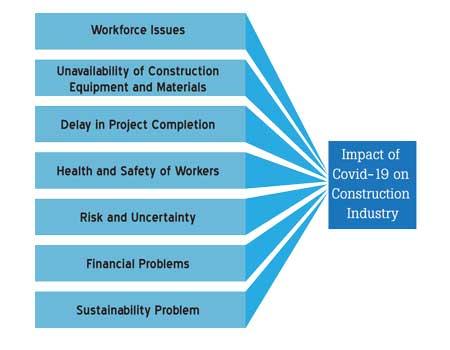12 Feb 2022 - {{hitsCtrl.values.hits}}

 Back in December 2019 the world experienced its first case of COVID-19 from Wuhan city, China, rapidly spread across the globe, flattering a global pandemic in March 2020 (World Health Organization, 2020). After the public health emergency issued by the WHO, to slow down the increasing number of cases day by day, many countries have chosen to impose nationwide lockdowns as a hasty action.
Back in December 2019 the world experienced its first case of COVID-19 from Wuhan city, China, rapidly spread across the globe, flattering a global pandemic in March 2020 (World Health Organization, 2020). After the public health emergency issued by the WHO, to slow down the increasing number of cases day by day, many countries have chosen to impose nationwide lockdowns as a hasty action.
Mapping of the Corona Virus Out Break Across the World
Covid-19 is affecting the global construction industry with projects facing supply chain issues, a break to planning and inspection timetables, and new measures to ensure the health and safety of the workforce. New social distancing measures have come into focus as international governments ratify their approaches to minimize the spread of the coronavirus.
This is an unprecedented condition, impacting family life and businesses everywhere. As a membership organization, there are actions we have already undertaken to support members and the wider industry. We have gathered this list of valuable resources to help our members and all industry professionals stay informed on the latest developments and official statements by professional bodies.

How has global construction activity fared in the face of COVID-19
The taking out of raw material to the production of construction materials, the overall construction industry, transportation of materials, inspection, labour, etc., has been facing trouble. Many workers become infected, quarantined, and sick, labour shortages had arisen, and this caused delays and effects in construction projects. These industries had faced difficulties with supply chain disturbances and labour insufficiencies even after the lockdown based on observed events. Also closed the international boundary between countries to countries.
Construction and engineering projects around the world are being squeezed by the COVID-19 pandemic in numerous ways, and many projects have stopped. How are these deep challenges being managed?

The Current Influence
COVID-19 is having a enormous impact on construction projects, but the legal implications vary from country to country, and contract to contract. On the contractual side, much focus is now being given to the wording of standard forms, where used, such as FIDIC [International Federation of Consulting Engineers] and NEC [National Electrical Cod]. As the COVID-19 situation is developing, further issues are arising.
At this stage, COVID-19 is not, broadly speaking, rendering projects altogether intolerable to complete. But it is slowing them down, causing delay and disruption, even if only because supply chains have been severally disrupted. Many projects have even stopped, usually with the intention to resume work at a later date.
A number of governments have also ordered those certain businesses stop working. However, the construction industry has generally not been the subject of ordered shutdowns. This is for a number of reasons, including:
The importance of the continuation, if possible, of construction and infrastructure projects; and The fact that the health and safety risks of COVID-19 vary from project to project. For example, people who are working outside, and are not physically close to each other, may be in a better position to comply with the new health and safety precautions than people working in an enclosed environment. In all cases, though, where work continues, health and safety risk assessments need to be conducted, reliable with medical, scientific and government guidelines, and contractors’ duty to provide a safe working environment.
That said, the situation is evolving and several countries have now ordered the suspension of all non-essential businesses, which would cover most construction projects. In a few countries, there have even been specific orders requiring construction sites to close, or entitling contractors to suspend works and to extensions of time until the end of the state of emergency period (especially in public works).

Contractual Implications
Contractually, events such as the COVID-19 pandemic generally do engage contractual provisions concerning the consequences of unforeseen events. These provisions commonly fall into two broad categories.
The first category concerns ‘force majeure’ which in broad terms refers to events unforeseeable at the time the contract was entered into, outside the affected party’s control, that cannot be prevented or overcome, and result in a party not being able to perform some or all of its obligations. The COVID-19 pandemic could thus be understood as constituting a force majeure event. Under many forms of contract, including the FIDIC forms, a force majeure event would typically entitle a contractor to an extension of time for critical delay caused by the event, but not to compensation for costs incurred during the period of delay, except in agreed-upon circumstances. As always, the actual wording of the applicable clause is important.
Force majeure will typically only excuse non-performance of those obligations, which are affected by the specific event. This raises questions, for instance when certain activities (e.g., design activities) can be continued, while others cannot. The requirement that the consequences of force majeure cannot be overcome is also potentially significant, because a contractor may be able to take measures to allow the works to continue, although at a reduced rate. Indeed some employers are refusing to acknowledge the existence of a force majeure situation on this very basis.
A second type of contractual provision is relevant and may yield a different legal effect. It concerns changes in law (and directions given by public authorities).
Construction and engineering projects are being impacted due to governments passing laws or regulations, or even giving directives, intended to address the pandemic. Placing restrictions on the movement of people or goods between or within countries, and requiring that certain people be ‘locked down’, usually represents a change of the law, which has an impact – perhaps an impact even greater on a contractor’s ability to progress works than the pandemic itself.
By contrast with force majeure, change in law provisions in construction and engineering contracts may confer a right to both an extension of time for the contractor and compensation for the unavoidable costs incurred due to the change in law.
Additional Considerations
In addition to these matters, consideration needs to be given to:
The applicable or background law – which may confer rights and impose obligations on top of the relevant contractual provisions. For instance, in certain jurisdictions the doctrines of rebus sic stantibus and hardship may allow parties to seek relief on the basis of an exceptional and unpredictable change of circumstances that affects the economics of the transaction.
Contractual notification provisions for the making of claims, and for keeping records of the impact of events;
Measures that have been or will be taken to try to overcome or mitigate the effects of the impacting events. Demonstrating these matters may be a critical aspect of any claim made due to the COVID-19 situation. Under many laws, parties must continue to consume all reasonably available means to continue performing their obligations, notwithstanding the existence of a force majeure event;

The possibility that a party may have to terminate the contract, if the force majeure event continues materially to prevent the performance of its obligations for a certain period of time; and
How the impact of COVID-19 should inform parties’ behavior when entering into construction and engineering contracts in the future . Matters requiring attention in this regard will include ensuring that there is symmetry of liability along the supply chains used for a particular project.
Finally, many governments are offering aid to persons and businesses negatively affected by the COVID-19 situation. So even if a contractor may have no contractual or legal entitlement to compensation for continuation costs due to work being significantly delayed or impaired, state aid may be available to cover some of the ongoing costs incurred, or otherwise provide a financial respite. Employers may also be entitled to the benefit of these state aid measures.
28 Nov 2024 17 minute ago
28 Nov 2024 2 hours ago
28 Nov 2024 5 hours ago
27 Nov 2024 8 hours ago
27 Nov 2024 9 hours ago